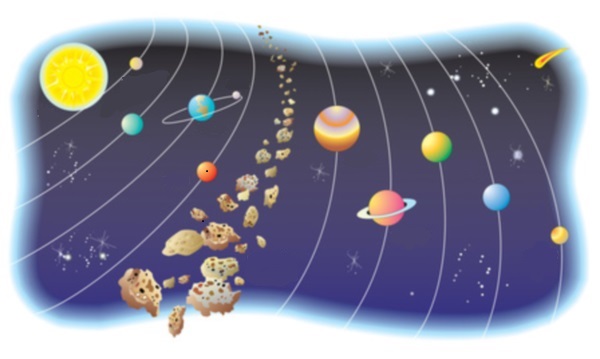The Solar System consists of The Sun, nine planets, corresponding moons around the planets and the asteroid belt.
The Sun is a star; it can produce its own light - and like any other star, appears to be blinking when viewed from Earth.
The planets are Mercury, Venus, Earth, Mars, Jupiter, Saturn, Uranus and Neptune.
The moon is a satellite and it orbits Earth.
The asteroid belt exists between Mars and Jupiter; it consists of 'fragments' of planets, known as asteroids.
Please move the mouse over a particular object to get more information.

A Mnemonic Phrase for Planets
My Very Eager Mother Just Served Us Noodles
Solar System Simulation
In this animation, The Sun is relatively stationary at the centre of The Solar System.
Earth is orbiting The Sun in a year - approximately in 365 days. It orbits its own axis which results in day and night within a period of 24 hours.
The Moon orbits Earth in a month - approximately in 28 days. Unlike Earth, The Moon does not move around its own axis.
As a result, the side of The Moon that faces Earth remains the same throughout its orbit - the side that we see.
A snapshot is taken every hour to illustrate the position of Earth in a period of 24 hours.
The simulation is created by HTML5 and JavaScript. Do you want to see the programming code that produced the above? Please visit this page.
Fascinating Facts
- Mercury is not the hottest planet, despite being the closest to The Sun: Venus is the hottest, due to The Greenhouse Effect; heat is trapped inside it owing to the presence of vast amount of CO2.
- Earth actually takes 363-1/4 days to complete the orbit around The Sun. So, we get a leap year in every four years - 4 X 1/4 = 1
- The Sun gets dark spots at regular intervals. So, there are corresponding effects on earth in the form of weather changes and fluctuations in the magnetic field.
|
Facts of Planets(Metric units) |
| Physical Properties | Mercury | Venus | Earth | Moon | Mars | Jupiter | Saturn | Uranus | Neptune |
|---|
| Mean diameter (km) |
4879 |
12,104 |
12,742 |
3475 |
6780 |
139,822 |
116,464 |
50,724 |
49,248 |
| Equatorial & polar diameter (km) |
4879 |
12,104 |
12,756
12,714 |
3475 |
6792
6752 |
142,984
133,708 |
120,536
108,728 |
51,118
49,946 |
49,528
48,682 |
| Mass (1024kg) |
0.330 |
4.87 |
5.97 |
0.073 |
0.642 |
1899 |
568 |
86.8 |
102 |
| Density (kg/m3) |
5427 |
5243 |
5515 |
3340 |
3933 |
1326 |
687 |
1270 |
1638 |
| Gravity (m/s2) |
3.7 |
8.9 |
9.8 |
1.6 |
3.7 |
23.1 |
9.0 |
8.7 |
11.0 |
| Escape Velocity (km/s) |
4.3 |
10.4 |
11.2 |
2.4 |
5.0 |
59.5 |
35.5 |
21.3 |
23.5 |
| Mean Temperature (C) |
167 |
464 |
15 |
-20 |
-65 |
-110 |
-140 |
-195 |
-200 |
| |
|
|
|
|
|
|
|
|
|
| Orbital Motion | Mercury | Venus | Earth | Moon | Mars | Jupiter | Saturn | Uranus | Neptune |
|---|
| Rotation Period (hours) |
1407.6 |
-5832.5 |
23.9 |
655.7 |
24.6 |
9.9 |
10.7 |
-17.2 |
16.1 |
| Length of Day (hours) |
4222.6 |
2802.0 |
24.0 |
708.7 |
24.7 |
9.9 |
10.7 |
17.2 |
16.1 |
| Distance from Sun (106 km) |
57.9 |
108.2 |
149.6 |
0.384* |
227.9 |
778.6 |
1433.5 |
2872.5 |
4495.1 |
| Orbital Period (days) |
88.0 |
224.7 |
365.2 |
27.3 |
687.0 |
4331 |
10,747 |
30,589 |
59,800 |
| Orbital Velocity (km/s) |
47.9 |
35.0 |
29.8 |
1.0 |
24.1 |
13.1 |
9.7 |
6.8 |
5.4 |
| Axial Tilt (degrees) |
0.01 |
177.4 |
23.4 |
6.7 |
25.2 |
3.1 |
26.7 |
97.8 |
28.3 |
Mild Fun
Do you want to get a 3-D feel of the Solar System? Here is the model for you. Just click it to access Amazon:


- Why does a star want to go school? -------click here for Answer
- If the moon was a clock, how would you call its tick? -------click here for Answer
- What is the kind of music heard around Neptune? -------click here for Answer
- Why do cows fancy space? -------click here for Answer
- Why do aliens prefer cats to dogs? -------click here for Answer
- According to a certain well-known author, men are from --- and women are from ---? -------click here for Answer
- Why is Saturn often accused of committing polygamy? -------click here for Answer
- What do aliens use to keep their food? -------click here for Answer
- What does The Solar System wear around its belly? -------click here for Answer
- What is the preferred chocolate bars of astronomers? -------click here for Answer